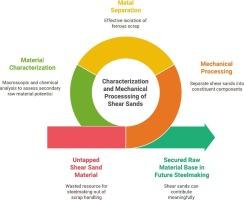Process-adapted material characterization for ferrous metal recovery from residues arising in scrap cutting operations
IF 7.1
2区 环境科学与生态学
Q1 ENGINEERING, ENVIRONMENTAL
引用次数: 0
Abstract
The transformation of Europe’s steel industry represents a flagship initiative of industrial decarbonization. In pursuit of a 55 % by mass reduction in process-related CO2 emissions by 2030 relative to 1990 levels, the sector is progressively transitioning towards secondary production pathways, with a particular emphasis on the establishment of electric arc furnace technology. This technological transition entails a fundamental change in the industry’s raw material base, as iron and steel scraps increasingly substitute for primary ores. Projections indicate a doubling of scrap demand over the coming decade.
This study explores the largely untapped potential of so-called shear sands − predominantly fine-grained residues generated during the cutting and downsizing of scrap using hydraulic shears, comprising for approximately 2 % by mass of the processed material stream. These residues are subjected to comprehensive mechanical processing and characterization, followed by a subsequent separation into distinct fractions. The primary objective is the mechanical recovery of ferrous scrap to elucidate its resource potential for integration into secondary production routes.
The findings demonstrate the feasibility of directly recovering a ferrous scrap fraction corresponding to approximately 27 % by mass of the original material. Additional fractions are likewise obtained and systematically characterized. Coarse fractions (>1 mm) are examined through visual and gravimetric methods, while fine fractions (<1 mm) are subjected to chemical analysis to identify patterns of elemental enrichment and depletion.
This investigation confirms that the recovery of shear sands can make a meaningful contribution to securing raw material for the transformation of Europe’s steel industry.

从废料切割操作中产生的残留物中回收黑色金属的工艺适应性材料表征。
欧洲钢铁工业的转型是工业脱碳的旗舰举措。为了实现到2030年与工艺相关的二氧化碳排放量在1990年的基础上大规模减少55%的目标,该行业正在逐步向二次生产途径过渡,特别强调电弧炉技术的建立。随着钢铁废料越来越多地取代原生矿石,这一技术转型将从根本上改变该行业的原材料基础。预测显示,未来10年,废钢需求将增加一倍。本研究探索了所谓的剪切砂的大量未开发潜力-主要是在使用液压剪切机切割和缩小废料尺寸时产生的细颗粒残留物,约占加工物料流质量的2%。这些残留物受到全面的机械加工和表征,随后分离成不同的分数。主要目标是铁废料的机械回收,以阐明其整合到二级生产路线的资源潜力。研究结果表明,直接回收相当于原材料质量约27%的铁废料是可行的。另外的馏分也同样得到并系统地表征。粗馏分(bb0 ~ 1mm)通过目测和重量法检测,而细馏分(
本文章由计算机程序翻译,如有差异,请以英文原文为准。
求助全文
约1分钟内获得全文
求助全文
来源期刊

Waste management
环境科学-工程:环境
CiteScore
15.60
自引率
6.20%
发文量
492
审稿时长
39 days
期刊介绍:
Waste Management is devoted to the presentation and discussion of information on solid wastes,it covers the entire lifecycle of solid. wastes.
Scope:
Addresses solid wastes in both industrialized and economically developing countries
Covers various types of solid wastes, including:
Municipal (e.g., residential, institutional, commercial, light industrial)
Agricultural
Special (e.g., C and D, healthcare, household hazardous wastes, sewage sludge)
 求助内容:
求助内容: 应助结果提醒方式:
应助结果提醒方式:


